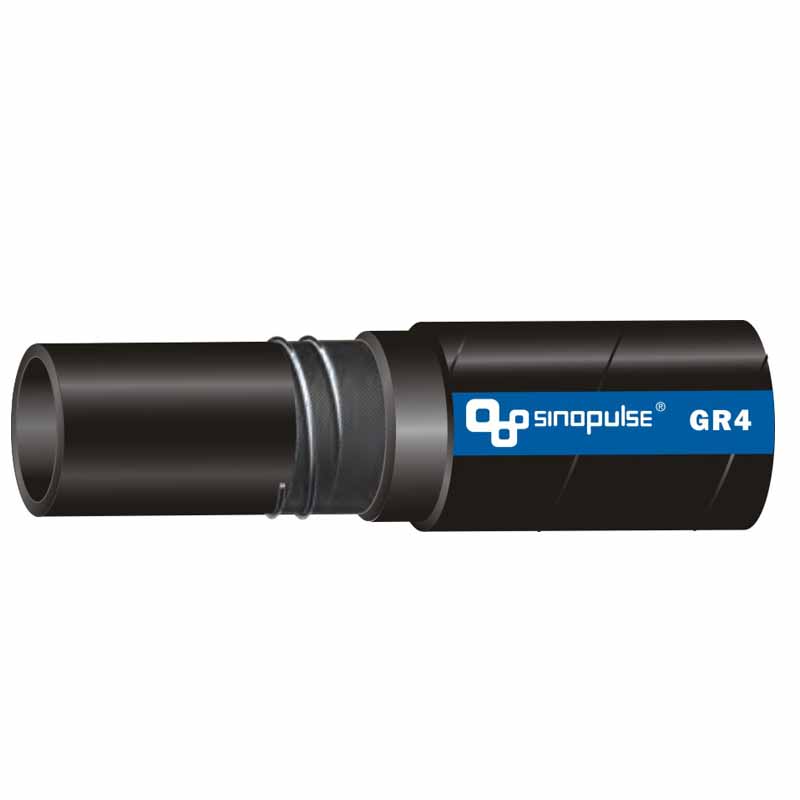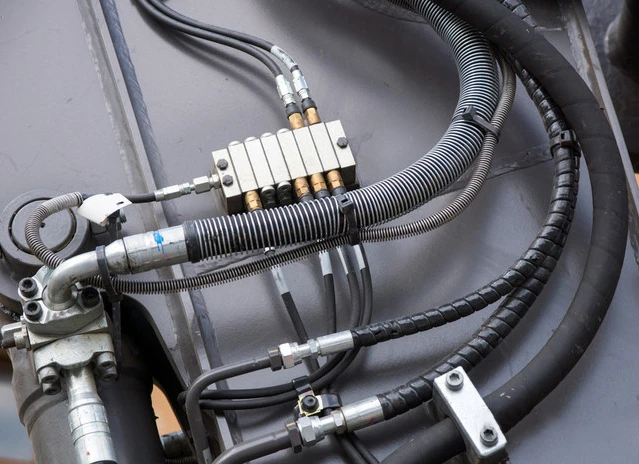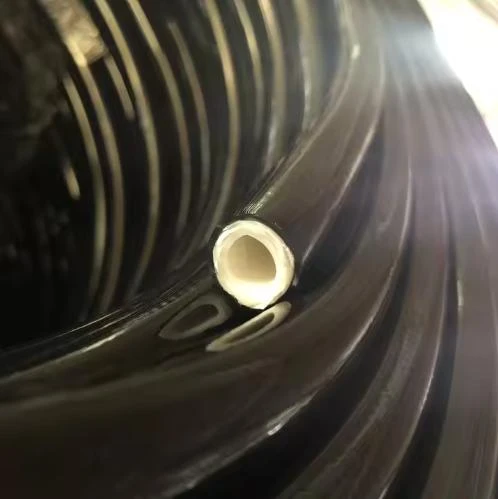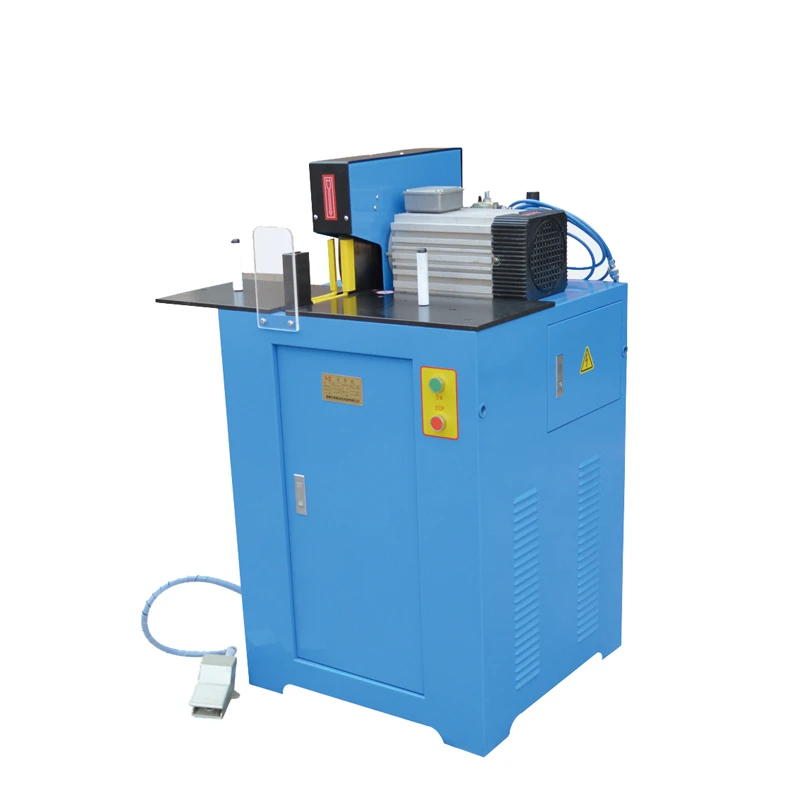Selang Hidrolik Suction
A hydraulic suction hose is a specially designed hose used in hydraulic systems to draw fluid from a reservoir or tank into the hydraulic pump. Unlike high-pressure hoses, suction hoses operate
under negative pressure or vacuum, making them critical for ensuring that the pump receives a consistent flow of hydraulic fluid without cavitation or air ingress. These hoses are constructed with an inner tube resistant to hydraulic fluids, reinforced with a spiral wire or textile braid for collapse resistance, and covered with an outer layer to protect against abrasion, weather, and external damage. Hydraulic suction hoses are typically more flexible than pressure hoses, allowing for easier routing in tight spaces and accommodating the low-pressure environment. They are used in various applications, including construction machinery, agricultural equipment, industrial systems, and marine hydraulics, where reliable fluid transfer is essential for maintaining system efficiency and preventing pump damage.
What Are the Main Features and Benefits of Hydraulic Suction Hoses?
Hydraulic suction hoses are engineered to handle the specific demands of drawing fluid into a pump, offering features that ensure reliable performance. One key feature is their resistance to negative pressure, achieved through reinforcements like spiral wire or textile braiding, which prevent the hose from collapsing under vacuum, a crucial aspect for vacuum suction hose applications. These hoses are typically made with an inner tube compatible with hydraulic fluids, ensuring resistance to oils, synthetic fluids, and other media. Their flexible construction, making them a type of flexible suction hose, allows for easy installation and routing, even in confined spaces or complex systems.
Industrial suction hoses, a common form of these hoses, often have an abrasion-resistant outer cover, protecting them from wear and tear in demanding industrial environments. Additionally, they are designed to operate in a wide temperature range, making them suitable for outdoor and industrial applications. In certain industrial and mobile machinery scenarios, fuel suction hoses, a specialized subset of these suction hoses, are used to draw fuel into engines. These features provide benefits such as preventing pump cavitation, reducing maintenance needs, and ensuring consistent hydraulic system performance, even under challenging operating conditions.
What Factors Should You Consider When Selecting a Hydraulic Suction Hose?
When choosing a hydraulic suction hose, several factors must be taken into account to ensure compatibility and reliable operation. The first consideration is the inner diameter of the hose, which must match the system’s requirements precisely to avoid flow restrictions or excessive resistance. The hose's vacuum rating is critical for the hydraulic suction hose, as it determines the hose's ability to resist collapse under negative pressure; this should exceed the maximum vacuum level of your system. Fluid compatibility is another essential factor; the hose's inner tube material must resist degradation from the hydraulic fluid used in the hydraulic suction hose, whether it's petroleum-based, synthetic, or water-based. The operating temperature range should align with the application's environmental conditions to avoid performance issues caused by extreme heat or cold. Reinforcement type and flexibility are also important aspects of the hydraulic suction hose, particularly for systems where the hydraulic suction hose requires tight bends or frequent movement. The outer cover should offer resistance to abrasion, weather, and chemicals, depending on the operating environment. Finally, check the manufacturer’s specifications and any applicable industry standards to ensure the hose meets your hydraulic system’s demands.
Application Scenarios of Fabric-Insert Suction Hydraulic Hoses
As a leading hydraulic hose manufacturer, SINOPULSE specializes in engineering high-quality hydraulic suction hoses designed for reliable low-pressure fluid transfer. Our fabric-insert suction hoses, compliant with SAE 100 R4 standards, combine flexibility, abrasion resistance, and robust reinforcement to excel in diverse industrial environments. Below, explore key applications where these hoses deliver optimal performance.
1. Construction Machinery: Flexible Suction for Heavy-Duty Equipment
In excavators, loaders, and bulldozers, suction lines must withstand constant vibration and tight routing around moving parts. SINOPULSE fabric-insert suction hoses feature a textile-reinforced layer that provides exceptional bend flexibility (minimum bend radius ≤15D), preventing kinking in articulated boom systems. Their smooth inner rubber lining ensures low-pressure drop during oil suction, critical for maintaining pump efficiency in cold starts (-40°C to +100°C temperature range). Available in sizes like 1 inch hydraulic suction hose, they seamlessly fit into standard machinery setups, reducing installation time and downtime from hose failures.
2. Agricultural Machinery: Durability in Harsh Field Conditions
Tractors, combines, and irrigation systems operate in dusty, wet, and chemically treated environments—challenging conditions for fluid transfer. Our suction hoses resist abrasion from crop debris and UV degradation from prolonged sunlight exposure, ensuring longevity in farm equipment. The fabric insert adds structural stability without compromising lightweight design, ideal for portable pumps and sprayers that require frequent repositioning. For custom hydraulic systems in specialty agricultural machinery, SINOPULSE offers custom hydraulic hoses with tailored lengths and end fittings, ensuring a perfect match for unique suction line configurations.
3. Industrial Hydraulic Systems: Reliable Low-Pressure Fluid Management
In manufacturing plants, hydraulic power units (HPUs) and reservoir systems rely on suction hoses to draw oil into pumps efficiently. SINOPULSE hoses meet strict SAE 100 R4 requirements for air and vapor resistance, preventing cavitation and noise in low-pressure zones. Their non-conductive rubber compounds are safe for use with mineral oils, water-glycol fluids, and biodegradable hydraulic oils, making them versatile for industrial applications from metalworking to food processing. For large-scale systems, our hoses are available in diameters up to 4 inches, with reinforced fabric layers that maintain shape under vacuum conditions (-0.9 bar pressure rating).
4. Marine and Offshore Equipment: Resistance to Corrosion and Saltwater
Marine cranes, deck machinery, and offshore platforms face relentless exposure to saltwater, humidity, and mechanical stress. SINOPULSE fabric-insert suction hoses feature a chloroprene rubber outer layer that resists marine corrosion and ozone, outlasting traditional hoses in coastal or offshore environments. The fabric reinforcement provides additional protection against abrasion from rigging or repetitive motion, critical for maintaining suction integrity in ship hydraulic systems. Their flexibility also simplifies installation in confined engine rooms, where space optimization is essential for vessel design.
5. Customized Solutions for Specialized Suction Needs
Every hydraulic system has unique requirements, which is why SINOPULSE offers custom hydraulic hoses designed to your specifications. Whether you need a specific length for a compact machinery layout, a non-standard fitting for legacy equipment, or a reinforced variant for high-vibration environments, our engineering team ensures precise matching to your suction line needs. We guide customers through hydraulic suction hose sizing considerations—including flow rate, pressure rating, and bend radius—to deliver solutions that enhance system reliability and efficiency.
Why Choose SINOPULSE Hydraulic Suction and Discharge Hoses?
Our hoses undergo rigorous testing, including burst pressure (3x working pressure) and impulse cycle (500,000+ cycles) evaluations, to meet international standards. As a trusted hydraulic hose manufacturer, we combine material expertise with application-driven design, ensuring our suction hoses excel in even the most demanding scenarios. From standard types of hydraulic hose to fully customized solutions, SINOPULSE delivers performance you can rely on.
Installation and Maintenance Guide for Spiral Steel Wire-Insert Suction Hydraulic Hoses
As a trusted hydraulic hose manufacturer, SINOPULSE understands that proper installation and maintenance are crucial for maximizing the lifespan and performance of hydraulic suction hoses. Our fabric-insert suction hoses, engineered to meet SAE 100 R4 standards, offer reliable low-pressure fluid transfer. Follow these guidelines to ensure optimal functionality across diverse applications.
Installation Best Practices
1. Sizing and Compatibility: Begin by confirming hydraulic suction hose sizing. Measure the required length accurately and select a diameter (such as the commonly used 1-inch hydraulic suction hose) that matches your system’s flow rate and pressure demands. Ensure the hose is compatible with your fluid type, whether mineral oil, water-glycol, or biodegradable hydraulic fluid.
2. Positioning and Routing: When routing the hose, avoid sharp bends or kinks. Fabric-insert hoses have a minimum bend radius (≤15D), and exceeding this limit can restrict flow and cause premature failure. Secure the hose with clamps at regular intervals to prevent vibration-induced abrasion, especially in high-movement applications like construction machinery.
3. End Fitting Connection: Use appropriate end fittings for your custom hydraulic hoses. Clean both the hose and fittings thoroughly before assembly. Apply a suitable lubricant to the hose end to ease insertion, and crimp the fittings according to SINOPULSE’s specifications to ensure a leak-free seal.
Maintenance and Inspection
1. Regular Visual Checks: Periodically inspect the hose for signs of wear, such as cracks, bulges, or abrasions. Pay close attention to areas near fittings, bends, or points of contact with other components. Replace any hose showing visible damage immediately to avoid system failures.
2. Fluid Compatibility Monitoring: Ensure the hydraulic fluid remains within the recommended temperature and chemical compatibility range for your hose. Contaminated or degraded fluid can degrade the hose material over time. Schedule regular fluid changes and filtration checks to maintain optimal performance.
3. Pressure and Leak Testing: Conduct routine pressure tests to verify the hose’s integrity. Apply 1.5 times the working pressure and monitor for leaks or abnormal swelling. In case of a leak, isolate the problem area, replace the faulty section, and retest the system.
By following these installation and maintenance tips, you can extend the lifespan of your SINOPULSE fabric-insert suction hoses and safeguard your hydraulic system’s efficiency. As experts in types of hydraulic hose, we’re committed to providing comprehensive support. Contact us for further assistance or to explore customized solutions tailored to your specific needs.












